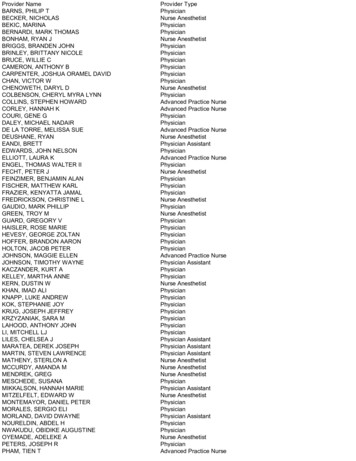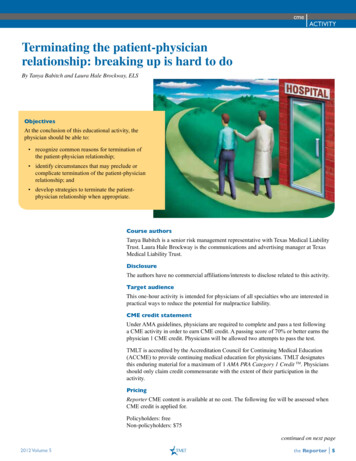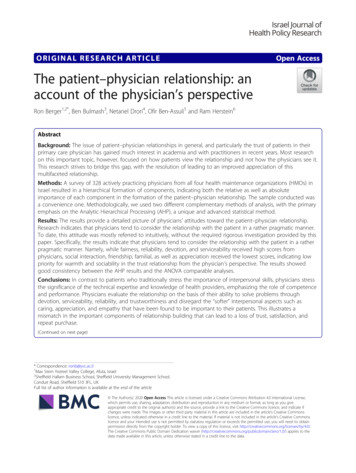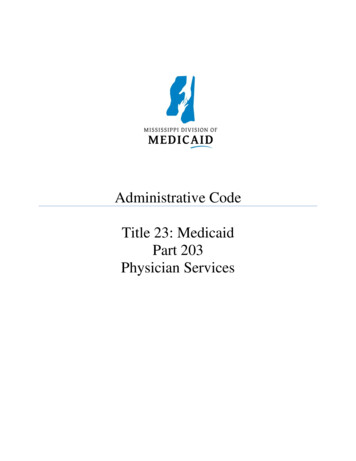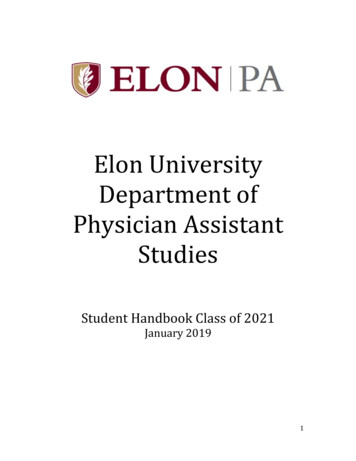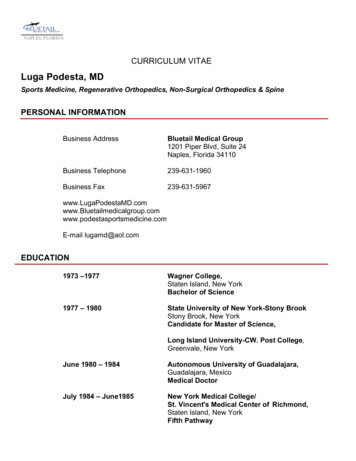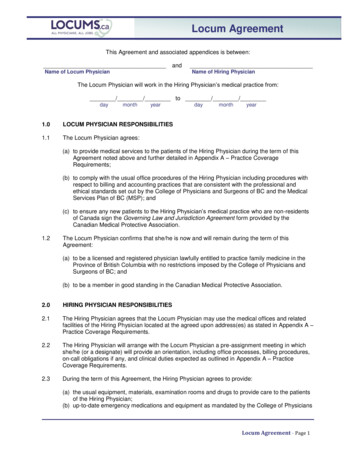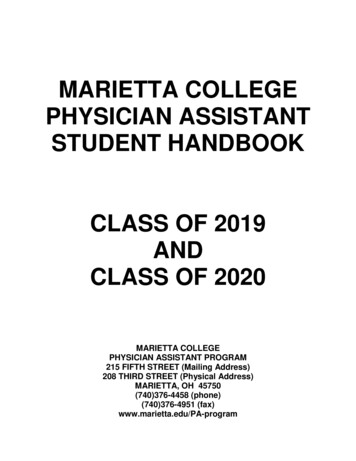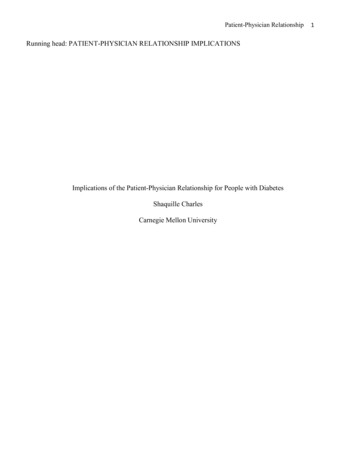
Transcription
Patient-Physician RelationshipRunning head: PATIENT-PHYSICIAN RELATIONSHIP IMPLICATIONSImplications of the Patient-Physician Relationship for People with DiabetesShaquille CharlesCarnegie Mellon University1
Patient-Physician Relationship2AbstractThe purpose of this study was to assess race differences (African Americans andCaucasians) in aspects of the patient-physician relationship, and then determine how the patientphysician relationship influences patient satisfaction, diabetes self-care behaviors and diabetesknowledge among adults with diabetes. Participants consisted of 99 adults with diabetes whowere currently receiving treatment for their diabetes. Participants were asked to complete a 15minute questionnaire that assessed aspects of the patient-physician relationship, includingpatient’s expectations of physician, actual patient-physician interactions, patient’s desire forinvolvement in the health care process, and collaboration between the patient and physicianregarding the patient’s treatment plan. We expected lower expectation scores and lessinvolvement in the health care process for African Americans than for Caucasians. We predictedthat higher expectation scores would be associated with lower levels of patient satisfaction withtheir physician. We also predicted that a greater desire for involvement and a more collaborativehealth care situation would be correlated with greater diabetes knowledge and better self-carebehaviors. Results indicate few race differences in the patient-physician relationship. Patientexpectation was not significantly associated with patient satisfaction but the discrepancy betweenexpectations and actual receipt was associated with satisfaction. There were trends indicatingthat patient desire for involvement and collaborative care were associated with better self-carebehaviors. Only one aspect of desire for involvement was related to diabetes knowledge.Although few race differences in the patient-physician relationship appeared, aspects of thatrelationship were associated with patient satisfaction and diabetes management and thoserelations may vary by race.
Patient-Physician Relationship3Implications of the Patient-Physician Relationship for People with DiabetesPrevious research indicates that African Americans are less likely to take proper care oftheir diabetes and are more likely to have poorer glycemic control compared to Caucasians.According to a population study conducted with participants enrolled in managed careorganizations, African Americans in general are significantly less likely to monitor their diet thanCaucasians (Oster, Welch, Schild, Gazmararian, Rask & Spettell, 2006). A qualitative studybased on semi-structured interviews revealed that African Americans diagnosed with diabetesare less likely to adhere to medical regimens or treatment plans than Caucasians (Peek, OdomsYoung, Quinn, Gorawara-Bhat, Wilson, & Chin, 2010). As a result of poorer self-care behaviors,African Americans have poorer glycemic control than Caucasians. A meta-analysis revealed thatAfrican American adults diagnosed with diabetes have higher HbA1c’s than Non-Hispanic whiteadults (Kirk et al, 2006). A more recent study that evaluated participants with diabetes whoenrolled in a self-management clinical trial concluded that African American participants had anaverage HbA 1 C of 8.14 2.53, while Caucasian participants had an average HbA 1 C of 7.40 1.71(Hausmann, Ren, & Sevick, 2010). One reason that African Americans have poorer self-careand suboptimal glycemic control compared to Caucasians might have to do with theirrelationship with their physician.Research has shown that African Americans are less happy with their physicianscompared to Caucasians. A telephone survey conducted with 1816 participants revealed thatAfrican Americans report less respect, less trust, less physician responsiveness, and, overall, lesspositive patient-physician interactions than Caucasians (Cooper-Patrick et al., 1999). Anobservational study showed that African American patients showed less positive affect thanCaucasian patients during their interactions with their physician (Johnson, Roter, & Cooper,2004). In addition, coders rated physician’s affective tone towards patients as less positive when
Patient-Physician Relationship4the patient was African American compared to Caucasian. Finally, according to a focus groupstudy, African Americans diagnosed with diabetes reported that physicians are more likely totalk down to them as patients, less likely to take their symptoms seriously and are less likely toconsider patient treatment preferences in comparison to Caucasian patients (Peek et al., 2010). Incomparison to Caucasians, African Americans see physicians who have lower levels of expertiseand fewer years of training (Johnson et al., 2004). The negative patient-physician interactions aswell as distrust in the health care process may explain why African American patients are lesssatisfied with the health care system compared to Caucasian patients.One reason for the racial discrepancy in physician satisfaction might be that AfricanAmerican patients are less likely than Caucasian patients to participate in the health care process.In-depth interviews conducted with 24 African American persons diagnosed with diabetesrevealed that African Americans perceive that physicians are less likely to explain test results tothem compared to Caucasians (Peek et al., 2010). African Americans also said that they wereless likely to consult or question the authority of a physician and were less likely to share theirsymptoms or health concerns. There are observational data to support the idea that physiciansinteract with African Americans and Caucasians differently. One observational study showedthat physicians were more verbally dominant when their patients were African American thanCaucasian (Johnson et al., 2004). Physicians talked 43% more than African American patientscompared to 24% more than Caucasian patients.Another key to patient satisfaction is “cultural competence.” A physician’s level ofcultural competence is assessed by the physician’s knowledge of patient culture, the physician’sattempt to understand patient culture, and the level at which physicians understand customsand/or values of a patient’s medical choices (Paez, Allen, & Cooper, 2009). In a cross-sectionalstudy of 123 patients who were seen by 26 different physicians, those who saw more culturally
Patient-Physician Relationship5competent physicians were more satisfied and reported greater seeking and sharing ofinformation with their healthcare provider (Paez et al. 2009). However, according to personalpatient anecdotes, not all physicians are culturally competent, which could result in ethnicminorities experiencing greater communication difficulties than Caucasians (Peek et al., 2010).Overall, African American patients rated their physicians as being less engaging compared toCaucasian patients (Cooper-Patrick et al. 1999).These racial discrepancies in interactions with physicians could be important becausepatient engagement in the health care process leads to better health outcomes (Lee & Emanuel,2013). Patient-centered care recognizes and customizes a patient’s health care process accordingto the patient’s needs, resources and preferences, and is clearly linked to better health outcomes(Stewart et al. 2000). Physicians fostering patient-centered care aim to get patients engaged andinvested in their own health care process. An observational study that involved third-yearmedical students revealed that patient-centered care was more strongly associated with animprovement in physician behavior among African American patients than Caucasian patients,which may play a role in reducing health care disparities (Beach, Rosner, Cooper, Duggan, &Shatzer, 2007). A study of 51 African Americans with diabetes showed that shared decisionmaking between patient and physician regarding diabetes treatment was associated with greaterdiabetes self-efficacy, enhanced self-care behaviors, and overall improved health (Peek et al.,2010). Thus, one way to reduce racial disparities in health between African Americans andCaucasians is to involve African Americans more in the health care process.The purpose of this study is to examine race differences in patient satisfaction withphysicians and diabetes self-care. We hypothesized that African Americans would be lesssatisfied with their physicians than Caucasians, and that African Americans would have lowerlevels of self-care than Caucasians. We expected that aspects of the patient-physician
Patient-Physician Relationship6relationship would explain these race differences in self-care. The first aspect of the patientphysician relationship that we anticipated would be associated with patient self-care behaviorswas patient expectations of their physician. We hypothesized that African American participantswould expect less communication, health promotion, and appreciation from physicians comparedto Caucasians. We also examined patients’ desire for both information from and involvementwith their physicians, evaluating how these desires can impact actual involvement and shareddecision making among African Americans and Caucasians with diabetes. We hypothesized thatCaucasians would reveal a greater desire for knowledge and involvement in their health careprocess than African Americans. We also hypothesized that a greater desire for involvement andinformation would be associated with more shared-decision making and better health outcomes,but that this relation would be stronger for Caucasians than African Americans. By identifyingthese factors and their respective associations, the health care process can be adjusted, resultingin a reduction of racial disparities in diabetes management among persons with diabetes.MethodParticipantsParticipants were recruited at the Senior Expo in Washington, Pennsylvania; at theDiabetes Expo in Pittsburgh, Pennsylvania; and Mt Ararat Baptist Church in Pittsburgh,Pennsylvania. Recruited participants had to have been diagnosed with diabetes and at least 18years of age. This study consisted of 99 adults diagnosed with type 1 (n 18) or type 2 (n 77)diabetes. Participant ages ranged from 26 to 86 with a mean of 60.32 years (SD 10.68). Thesample consisted of African American (n 45) and Caucasian (n 52) adults; the majority ofparticipants were women (69%).
Patient-Physician Relationship7ProcedureParticipants were asked to complete a 15-20 minute questionnaire. In return, participantsreceived 20 for their time.InstrumentsThe questionnaire evaluated patient expectations in a healthcare setting, actual patientinvolvement in the healthcare process, patient desire for involvement, collaborative healthcare,patient satisfaction with the healthcare process, diabetes knowledge, and self-care behaviors.Demographic variables. Participants were asked questions regarding their age, sex, race,education, income, employment status, diabetes type, diabetes length, and medication.Expectations of patient-physician relationship. Patient expectations were measuredwith the Consultation Questionnaire (Little et al., 2001). The questionnaire measured patientexpectations in regard to communication (4-items: Cronbach’s alpha .92), healthpromotion/prevention (2-items: r .82, p .001), and appreciating the whole person (1 item).Participants responded on a 6-point scale to indicate the extent to which they agreed or disagreedwith each item (1 completely disagree, 6 completely agree).Actual patient-physician relationship. We adapted the Consultation Questionnaire(Little et al., 2001) to assess the actual patient-physician relationship. The adapted version of theConsultation Questionnaire evaluated what the healthcare provider actually does rather than whatthe patient expects them to do. We used the same three scales: communication (4-items:Cronbach’s alpha .87), health promotion/prevention (2-items: r .72, p .001), andappreciating the whole person (1 item). Again, participants indicated on a 6-point scale the extentto which they agreed or disagreed with each item (1 completely disagree, 6 completelyagree).
Patient-Physician Relationship8Discrepancy between expectation and receipt. We computed the discrepancy betweenpatient-physician relationship expectations and actual patient-physician relationship scores onthe Consultation Questionnaire described above. Discrepancy scores were calculated in relationto communication, health promotion/prevention, and appreciation. Patient discrepanciesevaluated the extent to which patient expectations are met by what actually occurs. Lowerdiscrepancy scores indicated a greater extent to which patient expectations were met.Patient desire for involvement. Two scales were used to measure patient’s desire forinvolvement. First, patient desire for choosing a treatment plan was measured with one item fromthe Krantz Health Opinion Survey (Krantz, Baum, & Wideman, 1980) Information subscale: “I’drather be given choices about what’s best for my health than to have the doctor make thedecisions for me.” Participants indicated on a 5-point scale whether they agreed or disagreedwith the item (1 strongly disagree, 5 strongly agree). Second, we used seven items from the23-item Autonomy Preference Index that assesses the extent to which a participant desiresinformation regarding test results and treatment information, independent decision-making, andphysician decision-making (Ende, Ash, & Moskowitz, 1989). The scale evaluated preference forpersonal autonomy in decision–making (4-items: Cronbach’s alpha .49) and personalautonomy in information-seeking (3-items: Cronbach’s alpha .80). The decision-makingpreference subscale was further divided into doctor decision-making preference (2-items: r .63,p .001) and patient autonomous decision making preference (2-items: r .41, p .001).Participants responded on a 6-point scale to indicate the extent to which they agree or disagreewith each item (1 completely disagree, 6 completely agree). Thus, in total there were fourmeasures of desire for involvement.Collaborative healthcare. Collaborative healthcare was assessed with three items fromthe 9-item Shared Decision Making Questionnaire (Kriston, Scholl, Holzel, Simon, Loh, &
Patient-Physician Relationship9Harter, 2009). These items were: “My doctor and I always thoroughly weigh different treatmentoptions”, “My doctor and I always select a treatment option together”, and “My doctor and Ialways reach an agreement on how to proceed” (Cronbach’s alpha .71). Participants indicatedhow much they agreed or disagreed with each item on a 6-point scale (1 completely disagree, 6 completely agree).Patient satisfaction. Satisfaction was assessed with 4 items (Cronbach’s alpha .79)from the Patient’s Level of Satisfaction survey (Cooper-Patrick et al., 1999). These itemsassessed patient satisfaction regarding his or her overall healthcare, physician’s technical skills,physician’s personal manner, and physician explanation of patient treatment and disease.Participants responded on a 4-point scale to indicate the extent to which they were satisfied witheach item (1 not at all satisfied, 6 very satisfied).Self-care behaviors. Diabetes-related self-care was assessed with a 12-item (Cronbach’salpha .79) shortened version of the Summary of Diabetes Self-Care Activities Measure(Toobert, Hampson, & Glasgow, 2000), which assesses self-care with respect to diet (5-item:Cronbach’s alpha .68), exercise (3-item: Cronbach’s alpha .88), testing (2-item: r .79, p .001), and medication (2 items—insulin and oral medication; does not make sense to evaluate thecorrelation because most people answer only one of the two items). In this study, both overallself-care behaviors and self-care for each of the four domains were examined.Diabetes knowledge. Diabetes knowledge about exercise, blood sugar levels (2 items),HbA 1 c, and symptoms was examined with five true or false questions that were developed forthis study. Participants indicated whether they thought each item was true, false, or unsure.Participants received one point for a correct response and zero points for answering a questionincorrectly or if they were unsure. Scores can range from 0-5, with higher numbers indicating agreater level of diabetes knowledge.
Patient-Physician Relationship 10ResultsRace ComparisonsThe primary focus of this study was to identify differences between Caucasian andAfrican American participants in aspects of the physician relationship and self-care. Wehypothesized that African Americans would have lower physician expectations, desire forinvolvement, collaborative healthcare, knowledge, and self-care behaviors than Caucasians.However, we hypothesized that African Americans will have higher levels of satisfaction withtheir health care situation than Caucasians.Patient expectations of patient-physician relationship. There were no race differencesin expectations in physician communication or physician appreciation domains. However, therewas a trend indicating that African Americans (M 5.91; SD .22) had higher expectations thanCaucasians (M 5.68; SD .83) in physician health promotion/prevention, F (1, 95) 3.22, p .08.Actual patient-physician relationship. Similar to patient expectations, there were norace differences in actual patient-physician communication or patient-physician appreciation.However, a marginal race difference existed in the actual patient-physician healthpromotion/prevention domain: African Americans (M 5.54; SD .90) had higher levels ofactual patient-physician health promotion/prevention than Caucasians (M 5.21; SD .91),F (1, 95) 3.27, p .07.Discrepancy between expectation and receipt. When discrepancy scores betweenexpectations and receipt were examined, there were no race differences in whether physiciansmet patient expectations for any of the three domains—communication, healthpromotion/prevention, or appreciation.
Patient-Physician Relationship 11Desire for involvement. There were no race differences in participant desire forinvolvement in the healthcare process. African American and Caucasian participants displayedsimilar scores in the desire to choose a treatment plan. There were also no race differences inpreference for physician decision-making, personal autonomy in decision-making, and personalautonomy in information-seeking.Collaboration. There were no race differences in participant collaborative healthcaresituations.Satisfaction. There were no race differences in overall physician satisfaction. Patientsatisfaction scores were high for both African American (M 3.50; SD .56) and Caucasian (M 3.46; SD .50) participants.Self-care behaviors. Although there were no race differences in overall self-care,African American participants (M -.19; SD .94) were less likely than Caucasian participants(M .21; SD .90) to test their blood sugar levels, F (1, 95) 4.48, p .04, and were less likely(M -.05; SD .86) than Caucasian participants (M .27; SD .69) to take their diabetesmedication, F (1, 95) 4.72, p .05.Knowledge. There were no race differences in level of diabetes-related knowledge.Relation of Predictor Variables to OutcomesWe predicted that there would be race differences in self-care and expected that racedifferences in the patient-physician relationship would explain any observed race differences inself-care behavior. However, there were no race differences in any aspect of the physicianrelationship and no race differences in the overall self-care index. Thus, we turned our attentionto examining whether aspects of the physician relationship would be related to three outcomes:physician satisfaction, self-care behavior and diabetes knowledge. We hypothesized that higherexpectations of physicians to communicate, appreciate, and promote health/prevention would be
Patient-Physician Relationship 12related to lower levels of satisfaction. We hypothesized that lower discrepancies betweenexpectation and receipt of physician communication, patient appreciation, and healthpromotion/prevention would be associated with higher levels of satisfaction. We hypothesizedthat participants with a greater desire for involvement in their health care situation would exhibithigher levels of overall satisfaction, better self-care behaviors, and greater diabetes knowledge.We also hypothesized that patients who engage in a more collaborative health care situation withtheir physician will exhibit higher levels of patient satisfaction, self-care behaviors, andknowledge.Satisfaction. None of the three domains of patient expectations were related to physiciansatisfaction. Not surprisingly, the discrepancy between expectation and receipt was related tophysician satisfaction—lower satisfaction was associated with greater discrepancies incommunication, r -.55, p .001; health promotion/prevention, r -.50, p .001; andappreciation, r -.49, p .001. Desire for patient involvement was not related to overall patientsatisfaction regardless of the desire for involvement measure—desire for involvement inchoosing a treatment plan, autonomous decision-making preference, physician decision-makingpreference, and information-seeking preference. However, a more collaborative health caresituation was linked to greater levels of patient satisfaction, r .56, p .001.Self-care behaviors. Patient expectations as well as discrepancy scores across alldomains—communication, health promotion/prevention, and appreciation—were unrelated toself-care behavior. Autonomous decision-making preference, physician decision-makingpreference, and desire for involvement in choosing a treatment plan were unrelated to overallself-care. However, personal autonomy in information-seeking was marginally related to betteroverall self-care behaviors, r .17, p .09. When analyzing specific domains of self-care,personal autonomy in decision-making was marginally related to better exercise self-care
Patient-Physician Relationship 13behaviors, r .18, p .07, and personal autonomy in information-seeking was significantlyrelated to better diet-related self-care behaviors, r .23, p .02. Patients who engaged in a morecollaborative health care situation had marginally better self-care behaviors r .17, p .10.When self-care for each of the four domains were examined, a more collaborative health caresituation was associated with a better self-care behavior in the exercise domain, r .26, p .01.Knowledge. Patient expectations and discrepancy scores across all domains were notlinked to diabetes-related knowledge. Similarly, personal autonomy in decision-making, desirefor involvement when choosing a treatment plan, and personal autonomy in information-seekingwere unrelated to patient knowledge. However, physician decision-making preference wasrelated to lower diabetes-related knowledge scores. The more participants wanted their physicianto make treatment/health care decisions, the less the participant knew about diabetes, r -.32, p .001. Finally, the extent to which a patient engaged in a collaborative health care situation wasunrelated to their diabetes-related knowledge.Race Differences in Predictor Variables to Collaborative Care and OutcomesCollaboration. As shown in Table 1, greater preference for personal autonomy indecision-making and preference for physician decision-making were associated with a morecollaborative health care situation among Caucasians but not African Americans.Self-care behaviors. Higher levels of personal autonomy in information-seeking wasassociated with better self-care behaviors for Caucasians but not for African Americans.Similarly, more diabetes knowledge was associated with better overall self-care behaviors forCaucasian participants but not for African American participants.Knowledge. A greater preference for personal autonomy in decision-making wascorrelated with lower diabetes knowledge for Caucasians, but not for African Americans.
Patient-Physician Relationship 14However, a greater preference for personal autonomy in information-seeking was associated withless diabetes knowledge for African Americans but not for Caucasians.Relations among the Outcome VariablesPatient satisfaction was unrelated to diabetes knowledge and overall self-care behaviors.However, when considering the different domains of self-care, higher patient satisfaction wasassociated with better self-care behavior in the exercise domain, r .23, p .03. Diabetes-relatedknowledge was significantly related to better overall self-care behaviors, r .23, p .02.DiscussionRace DifferencesThere were no race differences in any aspect of the patient-physician relationship withthe exception of marginal differences in health promotion/prevention expectations and actualpatient-physician health promotion/prevention. African Americans had greater expectations forhealth promotion/prevention information and then received more health promotion andprevention information than Caucasians. These differences were opposite of our prediction thatAfrican American participants would have lower expectations of their physician than Caucasianparticipants. African Americans may have physicians who give more advice about healthpromotion and prevention than Caucasians because of their poorer self-care behaviors. Thefindings from this study are consistent with previous research that has shown African Americansengage in poorer self-care behaviors than Caucasians (Peek et al., 2010). A possible reason forthe lack of race differences in other aspects of the patient-physician relationship could be thatdifferences in the patient-physician relationship stem from socioeconomic status rather than race.Previous research has indicated that socioeconomic status moderates the relation between raceand the physician’s perceptions of the patient (Van Ryn & Burke, 2000). Physicians ratedAfrican Americans and patients with a lower socioeconomic status as less intelligent, having
Patient-Physician Relationship 15more negative personality characteristics, and less compliant with cardiac rehabilitationcompared to Caucasians and patients with a higher socioeconomic status. Future research shouldexamine whether race differences in the patient-physician relationship are due to socioeconomicstatus.Although there was no overall race difference in the self-care index, race differencesappeared on two of the four domains of self-care. As expected, African Americans participantswere less likely to test their blood glucose levels and regularly take their medication compared toCaucasian participants. These findings are problematic because poor self-care behavior is relatedto poorer glycemic control and poorer health outcomes overall. Research has shown that AfricanAmericans have more diabetes-related complications than Caucasians (Hausmann et al., 2010),and self-care behavior may be one reason. One potential explanation for poorer self-care on thepart of African Americans could be patient trust in the physician. African American participantsare less likely to trust their physician than Caucasian participants (Ebony Boulware, Cooper,Ratner, LaVeist, & Powe 2003). Future research should examine the extent to which racedifferences in physician trust contributes to race differences in self-care.Patient SatisfactionNeither patient expectations about what a physician should do nor patient reports of whatthe physician actually does predicted patients’ satisfaction with their physician. Instead, lowerdiscrepancies between expectations and receipt were associated with higher satisfaction scores.Therefore, the extent to which the physician meets a patient’s expectations is indicative of howsatisfied the participant is with his or her health care situation.One aspect of the patient-physician relationship that was associated with patientsatisfaction was collaborative care. The more collaborative participants viewed their health care,the more satisfied they were with their physician. Patients may be happier with physicians with
Patient-Physician Relationship 16whom they can collaborate because it allows them to exercise more control over their health caresituation. Other research has linked a patient’s perception of control to higher levels of patientsatisfaction (Hanna, Gonzalez-Fernandez, Barrett, Williams & Pronovost, 2012). Future researchshould investigate whether perceived control is a mediator of the relation between collaborativecare and patient satisfaction with physicians.It is important to consider factors that influence patient satisfaction with the physicianbecause satisfaction may be linked to how well patients adhere to physician advice. In thisstudy, patient satisfaction was linked to the exercise domain of self-care. The more satisfiedpatients were with their physician, the more they exercised. Exercise is an important area ofdiabetes management because it influences weight loss and blood glucose levels, which can helpto reduce complications of diabetes.Self-Care BehaviorThere were a number of variables that were associated with self-care behavior in thisstudy and they all had to do with patients’ desire for and actual involvement in the health careprocess. The extent to which both the patient and physician worked together to come up with atreatment plan was also linked to better self-care behaviors. One domain of autonomy in thehealth care process—personal autonomy in information-seeking—reflects people’s desires toknow more about their current condition, test results, and other information regarding theirdisease. This autonomy variable was linked to better self-care. One potential explanation for thisassociation is patient knowledge. When patients seek to gain more information regarding theirdisease and
Patient-Physician Relationship 6 relationship would explain these race differences in self -care. The first aspect of the patient - physician relationship that we anticipated would be associated with patient self -care behaviors was patient expectations of their physician. We hypothesized that African American participants


